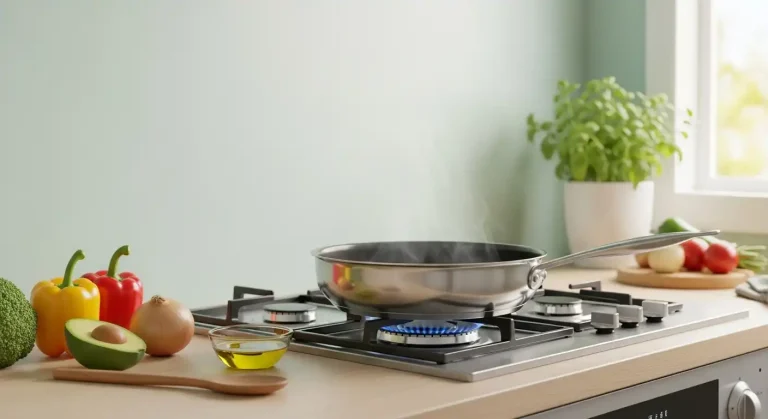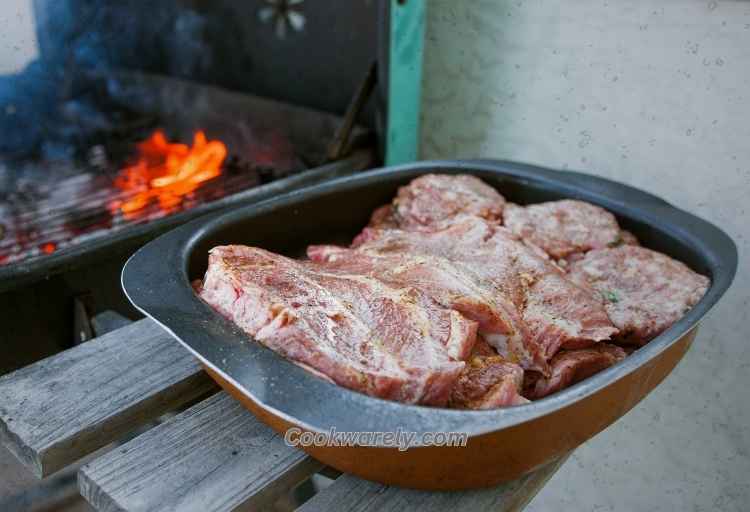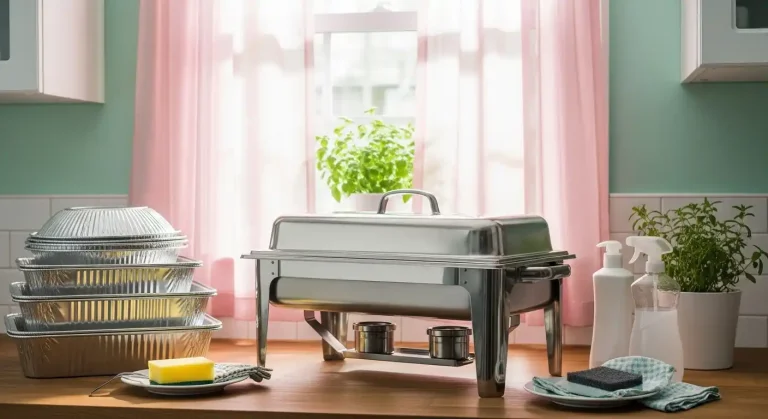How To Get Rid Of Discoloration On Stainless Steel Pots Efficiently and Safely

Discoloration on stainless steel pots is a common issue caused by heat exposure and mineral buildup.
It does not affect the functionality of the cookware but can make pots look dull and less appealing.
The most effective way to remove discoloration is by using a simple paste made from baking soda and water or a mixture of vinegar and baking soda applied to the affected areas.
This combination gently breaks down stains without damaging the stainless steel surface.
🎄 Christmas & Year-End Amazon Deals !
Don’t miss out on the best discounts and top-rated products available right now!
*As an Amazon Associate, I earn from qualifying purchases.
Regular cleaning and avoiding excessive heat can help prevent future discoloration.
Understanding these basic steps helps maintain the cookware’s appearance and longevity.
Causes Of Discoloration On Stainless Steel Pots
Discoloration on stainless steel pots results mainly from exposure to high heat and chemical interactions with various substances.
Both factors can alter the appearance by creating hues or stains that affect the shine and surface uniformity.
Heat-Induced Discoloration

Heat-induced discoloration happens when stainless steel is exposed to excessive temperatures.
This causes a layer of oxidation to form on the metal’s surface, often appearing as yellow, brown, blue, or rainbow-colored tints.
It commonly occurs when pots are overheated or boiled dry. The discoloration does not affect the cookware’s performance but can be visually unappealing.
Preventing this involves avoiding high heat settings when cooking and never allowing the pot to boil dry.
Chemical Reactions With Foods Or Cleaners
Certain foods and cleaning chemicals can react with stainless steel, causing stains or discoloration.
Acidic foods like tomatoes, vinegar, or citrus can leave marks after prolonged contact.
Harsh cleaners containing chlorine or bleach may also damage the surface, leading to discoloration or pitting.
Water with high mineral content (hard water) can leave behind mineral deposits or white spots that look like stains.
Cleaning with gentle, non-abrasive agents and rinsing thoroughly after use helps minimize this effect.
Avoiding prolonged contact with acidic substances protects the pot’s finish.
🎄 Christmas & Year-End Amazon Deals !
Don’t miss out on the best discounts and top-rated products available right now!
*As an Amazon Associate, I earn from qualifying purchases.
Effective Methods To Remove Discoloration
Discoloration on stainless steel pots often results from heat, water deposits, or food reactions.
Removing these stains requires targeted cleaning approaches, combining manual effort, natural ingredients, or specialized cleaners.
Regular care helps maintain the pot’s appearance and prevents recurring discoloration.
Manual Cleaning Techniques
Manual cleaning usually starts with gentle abrasives like baking soda and water.
A paste made from these ingredients is applied to the stained areas and gently scrubbed with a soft cloth or nonabrasive sponge.
This method is effective for light to moderate discoloration and safely removes surface stains without damaging the steel.
For tougher discoloration, such as heat marks or burnt residue, scrubbing with a nylon brush or steel wool may be necessary.
She should be careful to avoid overly harsh scrubbing that can scratch the surface.
Rinsing thoroughly and drying with a microfiber cloth prevents water spots afterward.
Natural Cleaning Solutions

Vinegar is a common natural solution, effective at removing rainbow-colored discoloration caused by heat.
Soaking a cloth in white vinegar and wiping the affected areas breaks down mineral deposits and oxide layers.
After leaving it for a few minutes, rinsing and drying the pot restores the shine.
🎄 Christmas & Year-End Amazon Deals !
Don’t miss out on the best discounts and top-rated products available right now!
*As an Amazon Associate, I earn from qualifying purchases.
Tomato sauce or lemon juice can also help with discoloration caused by food residues. Their mild acidity aids in dissolving stains.
Users should avoid prolonged exposure to acidic solutions to prevent metal damage.
Baking soda mixed with water or cream of tartar forms gentle abrasives that can lift stains when scrubbed lightly.
Using Commercial Stainless Steel Cleaners
Commercial cleaners are formulated for specialized stain removal and restoring shine.
These cleaners often contain mild acids or polishing agents designed to remove tough discolorations without scratching the surface.
Applying the cleaner with a soft cloth according to the product’s instructions guarantees even results.
It is important to select a cleaner specifically made for stainless steel to avoid damage.
After cleaning, pots should be fully rinsed and dried to remove any residue.
Commercial options can be particularly useful for dark heat stains or persistent discoloration resistant to home remedies.
Preventive Maintenance Tips

Preventing discoloration starts with avoiding high heat that causes oxide layers to form.
Cooking on medium temperatures reduces stress on the steel surface.
Using wooden or silicone utensils helps prevent scratches that can trap stains.
🎄 Christmas & Year-End Amazon Deals !
Don’t miss out on the best discounts and top-rated products available right now!
*As an Amazon Associate, I earn from qualifying purchases.
Immediate drying after washing prevents water spots and mineral buildup. Regularly cleaning pots with mild detergent and soft cloths avoids residue accumulation.
Storing pots in dry areas also minimizes exposure to moisture that can cause discoloration.
Combining Stainless Steel and Cast Iron in the Kitchen
Both stainless steel and cast iron cookware have their place in the kitchen, but they require different maintenance routines.
For example, unlike stainless steel, cast iron skillets require seasoning. Learn how to take care of yours in this helpful post on seasoning a cast iron Dutch oven.
If you’re curious whether cast iron is safe on different surfaces, check out our tips on whether cast iron will scratch an induction cooktop.
Final Thoughts on How To Get Rid Of Discoloration On Stainless Steel Pots
Discoloration on your stainless steel cookware might seem frustrating at first, but the solutions are simple, natural, and effective.
Whether you’re dealing with rainbow heat stains, water spots, or food residue, everyday kitchen items like vinegar, lemon juice, and baking soda will restore your pots’ shine.
So, the next time someone asks how to get rid of discoloration on stainless steel pots, you’ll have all the answers—and a gleaming set of cookware to show for it.
If you’re expanding your kitchen arsenal, be sure to also check out the differences between what you can use instead of a cast iron skillet or whether cast iron can safely go in the fridge.
FAQs About Stainless Steel Discoloration
Q: How often should I deep clean my stainless steel pots?
A: For most home cooks, a deep clean once a month or whenever you notice discoloration is enough. Regular washing after each use helps maintain shine.
Q: Can I use my discolored stainless steel pot on an induction cooktop?
A: Absolutely. Stainless steel works perfectly on induction cooktops, discoloration or not. If you’re wondering about other cookware compatibility, read about whether a cast iron skillet can be used on an induction cooktop.
Q: What if my pot has black or brown burnt food stains?
A: Simmering water and baking soda together can help lift burnt residue. You can also try a stainless steel cleaner for tougher stains.
🎄 Christmas & Year-End Amazon Deals !
Don’t miss out on the best discounts and top-rated products available right now!
*As an Amazon Associate, I earn from qualifying purchases.






